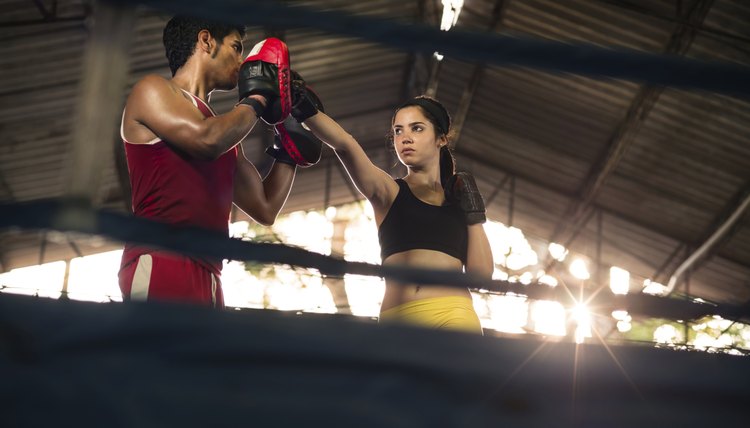Boxing Training for Teens

Getting into the ring to begin your boxing career can start during your teenage years. It is often best to learn the sport early on because you can develop great habits in the ring when you train under the eye of an attentive trainer. Young boxers have to get themselves in excellent condition if they are going to be able to attack and defend themselves in the ring.
Conditioning
The first aspect a teenager has to work at before getting into the ring is conditioning. In order to box without putting yourself in a position where you're as risk of getting hurt, work on getting in top shape. It may be easier for young people to get in good shape than older people because they recover quickly, but intense work needs to be done to get there. Road work is the first pre-requisite, and that usually includes running three to four miles at a time three or four times per week. Keep your intensity high, at up to 85 percent of your maximum heart rate. Jumping rope is another conditioning exercise common among boxers and should always be a part of your workout. Hitting the speed bag, lifting weights and doing ab crunches are also essential when it comes to getting shape for boxing.
Footwork
Teen boxers have to learn footwork before they get into the ring against an opponent. This means building up the leg muscles so you can move quickly to throw a punch and also avoid one. Two of the top exercises to improve footwork include jumping rope and shadow boxing. Jumping rope will improve your quickness and coordination. Shadow boxing will get you used to the specific movements in boxing. You will have to shuffle your feet quickly to advance into an opening and then retreat when your opponent is on the attack. These movements have to become instinctive to the teen boxer.
Punching Combinations
Throwing punches in combinations is essential for a teenage boxer. It's not enough to throw one punch and retreat and throw another punch and retreat. You have to throw punches in combinations and do so from a variety of angles. This is done by hitting the heavy bag in two-, three-, four- and five-punch combinations. A simple combination to master is a double jab, straight right and left hook. When in the ring with the trainer, he will wear target gloves that allow him to absorb punches without pain. He will move those target gloves and that will help the fighter learn to throw punches accurately.
Heavy Bag Training
One of the most shocking aspects for a young person who gets into the ring for the first time is learning how to throw a hard punch with consistency. It's not just about using your fists, arms and shoulders. A power punch is thrown with the force of your entire body. Start the punch in your legs and use the power in your hips, glutes, lower back and core muscles in addition to your arms. Hit the bag for two to three minutes in an effort to improve punching power.
Sparring
Sparring is the big test before a young fighter goes into the ring in an actual bout, but sparring isn't a reckless exercise. Technical sparring allows boxers to get used to the feel of being in the ring and being hit. In a technical session, a trainer might instruct each boxer to only throw punches with his left hand, for example. Once each boxer is comfortable with contact drills, he can begin light, controlled sparring.
Writer Bio
Steve Silverman is an award-winning writer, covering sports since 1980. Silverman authored The Minnesota Vikings: The Good, The Bad and The Ugly and Who's Better, Who's Best in Football -- The Top 60 Players of All-Time, among others, and placed in the Pro Football Writers of America awards three times. Silverman holds a Master of Science in journalism from the Medill School of Journalism.
